Want to know how to make a juicy turkey? Unlock the secrets to cooking a perfect Thanksgiving turkey with expert tips and step-by-step guidance.
There’s nothing like a gorgeous roast turkey for the holidays. From preparation to carving, discover the ultimate turkey cooking guide for your holiday feast, including the best turkey I’ve ever made.
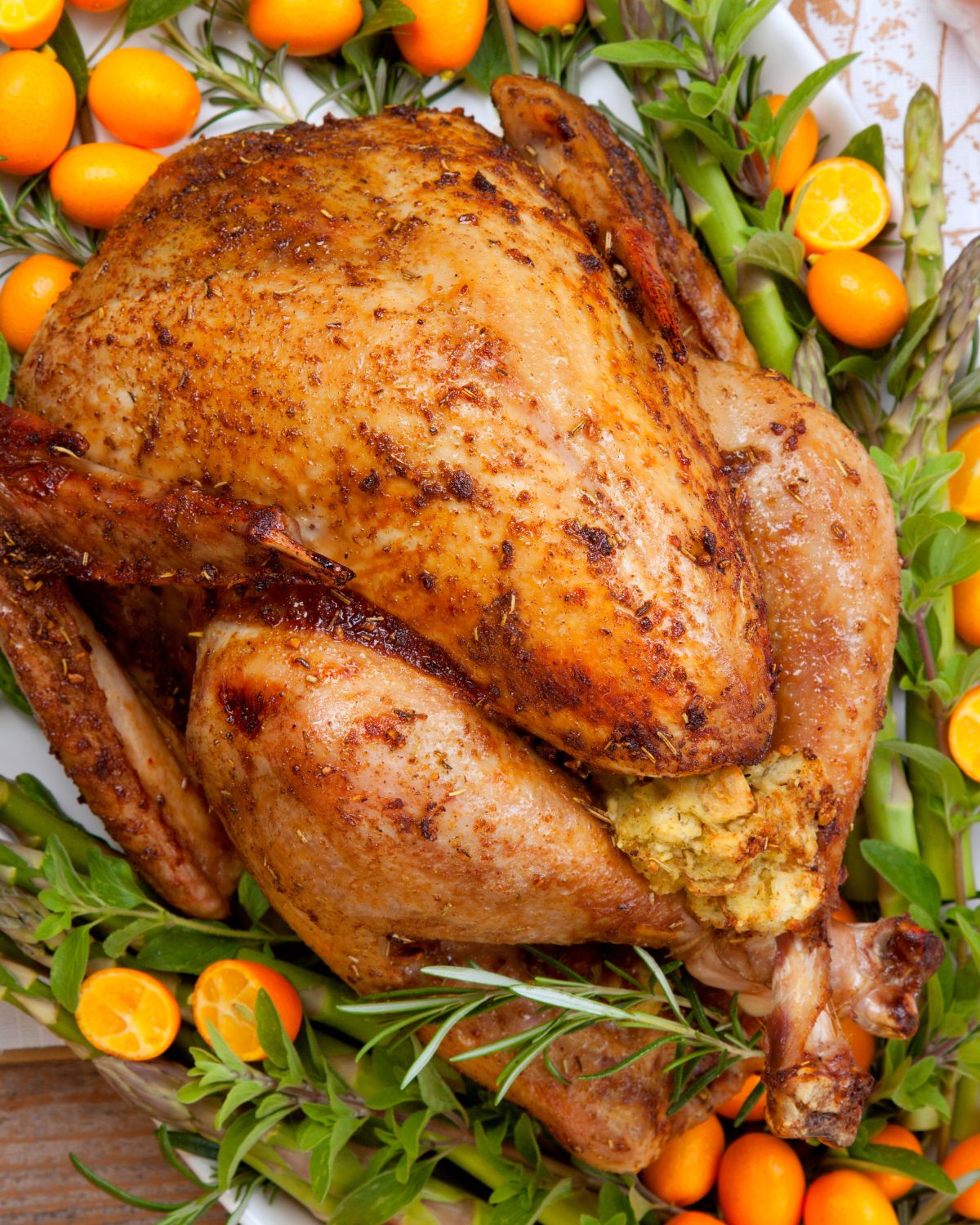
SAVE THIS RECIPE!
Enter your email below and we’ll send this recipe straight to your inbox.
How to Make a Thanksgiving Turkey
Cooking up the perfect turkey isn’t just about following a recipe; it also includes preparation. In this guide, we cover everything from prepping your bird to seasoning and cooking and even serving. The result will be a moist and delicious turkey your family and friends will love.
Whether this is your first turkey or you’re a seasoned veteran, you’ll learn everything you need to know about how to make the juiciest turkey ever.
And, if you need help planning a successful holiday meal, check out Ultimate Thanksgiving Planner and our Ultimate Christmas Planner.
How to Prep a Turkey
Prepping your turkey for Thanksgiving before cooking is a critical step that can’t be overlooked. Proper preparation not only ensures food safety but also plays a significant role in flavor infusion.
Seasoning the turkey with your choice of herbs, spices, and perhaps even brining it, allows these flavors to penetrate the meat. Prepping is not just about aesthetics; it sets the stage for a tender and juicy turkey.
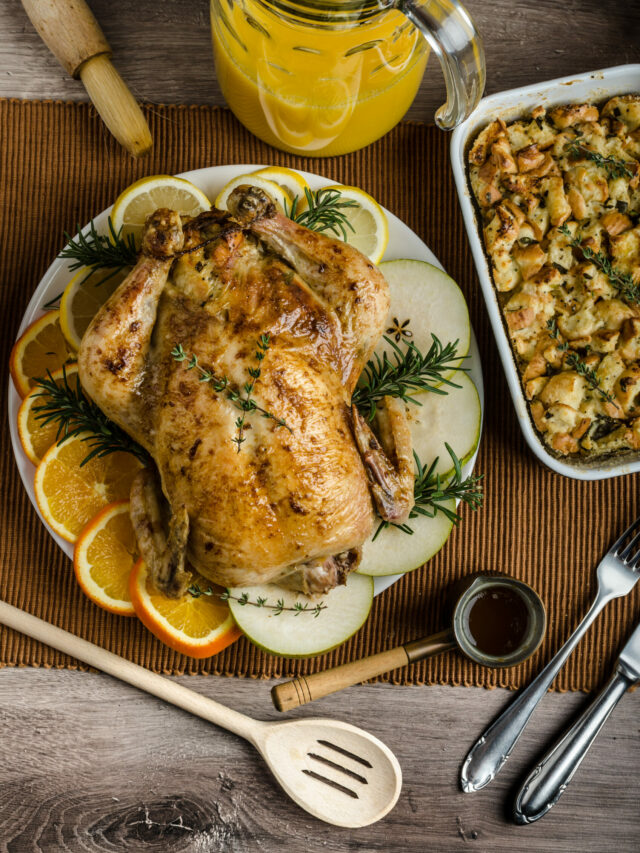
Fresh vs Frozen Turkey
When it comes to turkeys for Thanksgiving dinner, there are two types: fresh and frozen.
Fresh is when the turkey came from the farm and has never been frozen.
Frozen means the turkey was processed and then frozen before shipping to the grocer.
Each has its own pros and cons. Here’s a break down to help you decide which is right for you:
Fresh Turkey:
- Availability: Fresh turkeys are typically available closer to the holiday season, so you may have a wider selection closer to Thanksgiving or Christmas.
- Convenience: You don’t need to worry about thawing, as fresh turkeys are ready to cook immediately.
- Texture: Fresh turkeys may have slightly better texture and moisture compared to frozen ones.
- Flavor: Some people believe that fresh turkeys have a more natural and vibrant flavor.
- Shorter Shelf Life: Fresh turkeys have a shorter shelf life, so you need to plan your purchase closer to your cooking date.
- Price: Fresh turkeys are often more expensive than their frozen counterparts due to the convenience of being ready to cook.
Frozen Turkey:
- Longer Shelf Life: Frozen turkeys can be purchased well in advance and stored in the freezer until needed, making them more flexible for meal planning.
- Availability: Frozen turkeys are usually available year-round, so you can buy them whenever it’s convenient for you.
- Price: Frozen turkeys are generally more budget-friendly than fresh ones.
- Thawing Required: You’ll need to plan ahead and allow ample time for thawing, typically about 24 hours for every 4-5 pounds of turkey in the refrigerator.
- No Immediate Use: Unlike fresh turkeys, frozen ones require some advance preparation, including thawing, before you can start cooking.
WE RECOMMEND: Convection Oven Turkey
How to Safely Thaw a Turkey
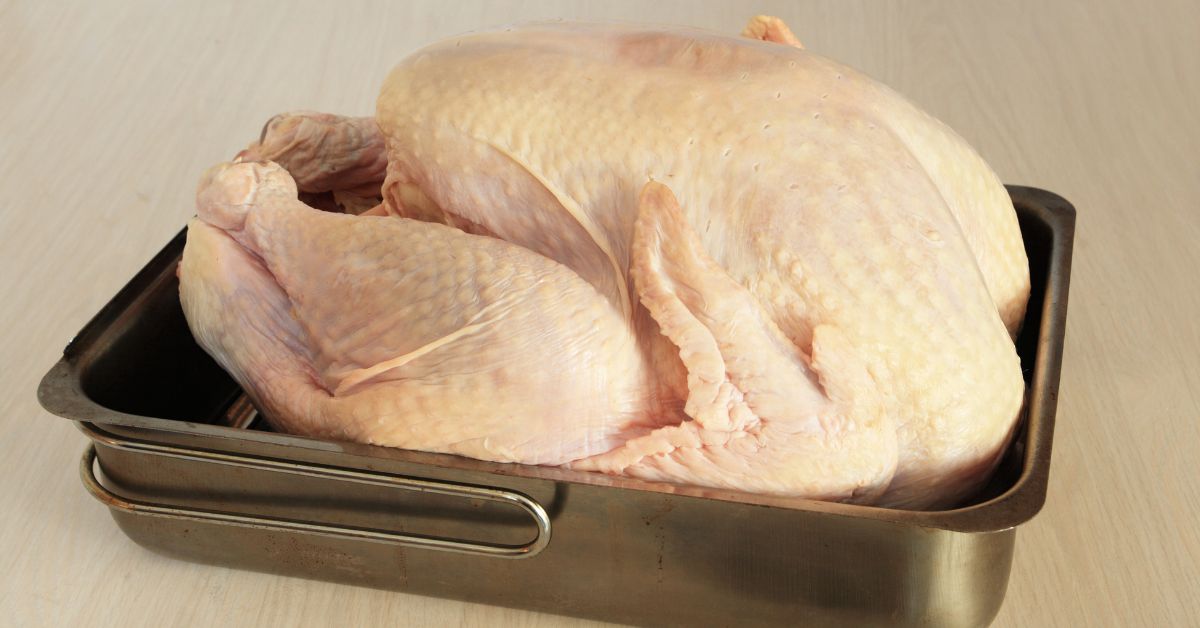
When using a frozen turkey, you need to allow plenty of time for thawing. This is a big mistake many people make the first time cooking a turkey.
Always prioritize safety when thawing a turkey to prevent the growth of harmful bacteria.
Refrigerator thawing is the most reliable and safest method for thorough and even thawing.
- Plan Ahead: Allow enough time for the turkey to thaw properly. Thawing takes time, typically about 24 hours for every 4-5 pounds of turkey, so plan accordingly.
- Refrigerator Thawing: The safest method is to thaw the turkey in the refrigerator. Place the turkey, still in its original packaging or in a leak-proof bag, on a tray or in a shallow pan to catch any drips. Keep the temperature of the refrigerator at or below 40°F.
- Calculate Thawing Time: Estimate the thawing time based on the turkey’s weight. For example, a 12-pound turkey will take approximately 2-3 days to thaw in the refrigerator.
- Check Daily: Check the turkey daily to ensure it’s thawing correctly and to monitor any potential leakage. If you notice any leaks, be sure to clean and sanitize the area immediately.
- Cold Water Thawing: If you need to thaw the turkey more quickly, you can use the cold water method. Place the turkey in its original packaging or a watertight plastic bag. Submerge it in cold water in a sink or large container.
- Change Water Regularly: Change the cold water every 30 minutes to maintain a safe temperature. Estimate approximately 30 minutes of thawing time per pound of turkey using this method.
- Cook Immediately: Once the turkey is fully thawed, cook it immediately. Do not refreeze a turkey that has been thawed using the cold water method.
WE RECOMMEND: Best Way to Thaw a Turkey
How to Clean Turkey
Before you can season or cook your turkey, you need to ensure its properly cleaned. Not only does this help with cooking, but also for food safety reasons.
Here’s how to clean a turkey:
- Rinse Turkey: Remove turkey from the package. Place the turkey in the sink and rinse it under cold, running water. This helps remove any ice crystals, loose pieces, or excess juices from the packaging.
- Inspect Cavity: Carefully inspect the turkey’s cavity. Remove any remaining giblets (such as the neck, heart, liver, and gizzard) or other internal organs from the neck and/or tail cavities.
- Pat Dry: Pat the turkey dry with paper towels – inside and out. This helps remove excess moisture, which can interfere with browning during roasting and can also help seasonings adhere better to the skin.
- Check for Feathers or Pinfeathers: Examine the skin for any remaining feathers or pinfeathers. Use tweezers or pliers to gently pull them out if necessary.
- Trim Excess Fat and Skin: Trim any excess fat or loose skin around the neck and cavity area. This helps improve the appearance of the turkey and prevents flare-ups during roasting.
- Dispose of Packaging Safely: Properly dispose of the turkey’s packaging, especially any plastic wrap or absorbent pads that may have been inside the packaging.
- Wash Hands and Surfaces: After handling the turkey, thoroughly wash your hands, sink, cutting board, and any utensils or surfaces that came into contact with raw turkey to prevent cross-contamination.
- Cook Immediately: Once the turkey is cleaned, seasoned, or brined, it’s ready to be cooked immediately. Do not let it sit at room temperature, as this can allow harmful bacteria to multiply.
WE RECOMMEND: Juicy Turkey in an Oven Bag
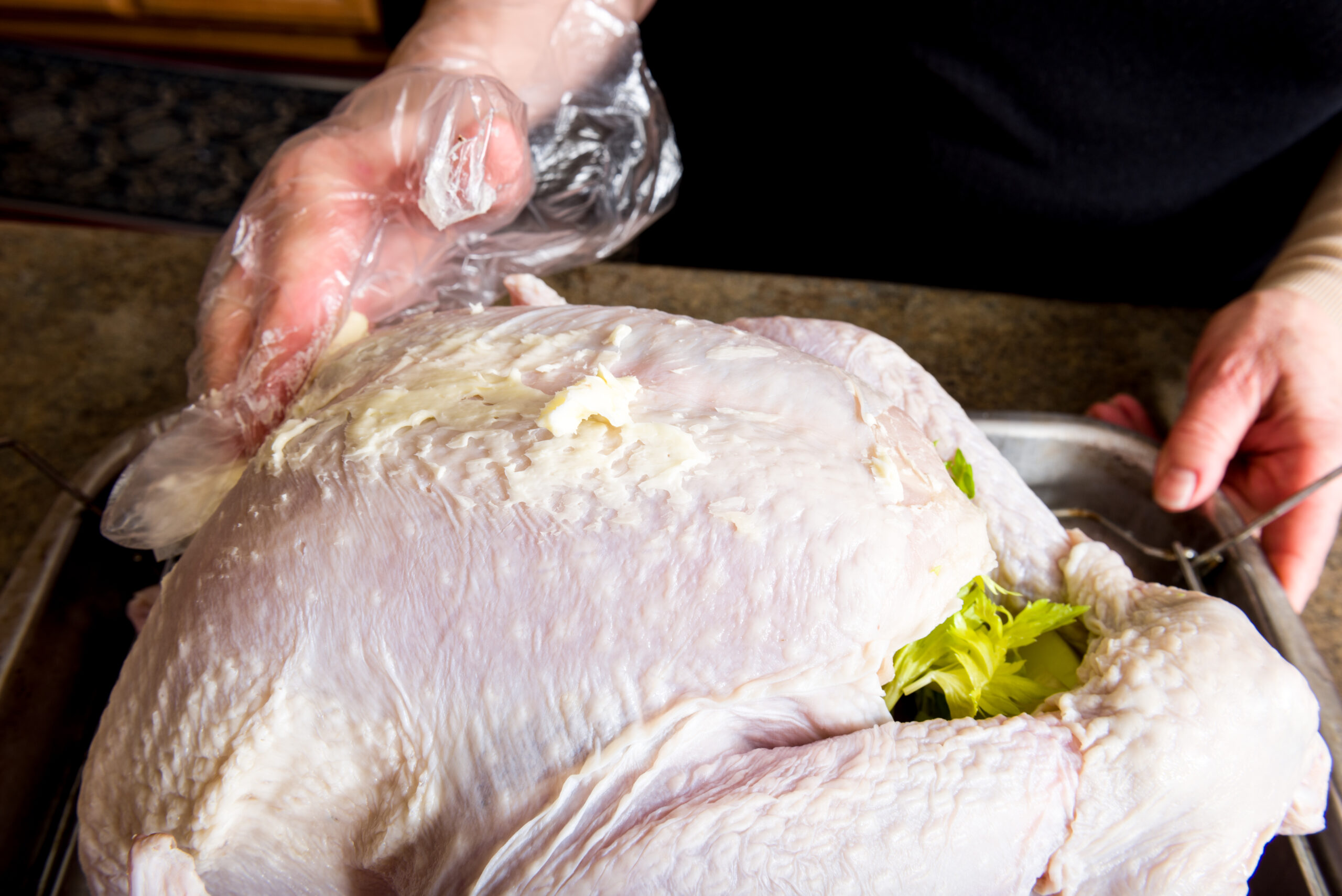
How to Season a Turkey
Seasoning a turkey before cooking it ensures that the finished bird will have great flavor. Proper seasoning also help the turkey retain its moisture while cooking for the best Thanksgiving turkey.
Remember that the amount of seasoning needed may vary depending on the turkey’s size and your personal taste. Turkeys tend to be large so make sure you use enough seasoning.
- Season Inside and Out: Season the exterior and the cavity of the turkey. Sprinkle salt and pepper inside the cavity for even seasoning.
- Salt Liberally: Generously season the entire turkey with kosher salt. The salt enhances the flavor and helps create a crispy skin.
- Pepper and Herbs: Apply freshly ground black pepper for a bit of heat and add herbs for aromatic flavor. Common herbs include thyme, rosemary, sage, and parsley.
- Garlic and Onions: Consider placing garlic cloves, onion quarters, or citrus slices inside the turkey’s cavity to infuse additional flavor.
- Butter or Oil: Rub softened butter or olive oil all over the outside of the turkey, including the top of the turkey. This helps create a golden, crispy skin of the turkey and adds richness to the flavor.
- Optional Seasonings: Get creative with additional seasonings like paprika, cayenne pepper, or your favorite spice blends for a unique flavor profile. You can even season the turkey with aromatics and herbs or lemon wedges inside the turkey cavity.
- Brining (Optional): If desired, you can brine the turkey in a saltwater solution with added herbs and spices for several hours or overnight before cooking. This step enhances moisture and flavor.
- Marinade (Optional): For a deeper flavor, marinate the turkey in a flavorful mixture of oil, herbs, spices, and acid (such as citrus juice or vinegar) for several hours or overnight.
- Allow Seasonings to Set: After seasoning, let the turkey sit for a while in the refrigerator, ideally for a few hours or overnight, to allow the flavors to penetrate the meat.
WE RECOMMEND: Citrus Turkey Brine
Stuffing a Turkey – What You Need to Know
- Can I stuff a turkey the night before? It’s not recommended to stuff a turkey the night before. Stuffing should be prepared and cooked immediately before roasting to prevent bacterial growth.
- How much stuffing should I use for my turkey? A general guideline is about 3/4 cup to 1 cup of stuffing per pound of turkey. Adjust the quantity based on the turkey’s size and how loosely or tightly you want to stuff it.
- Can I use raw stuffing in the turkey? No, you should never use raw stuffing in the turkey. Stuffing should be fully cooked before it’s placed inside the bird to ensure food safety.
- How do I prevent overcooking the turkey while the stuffing cooks inside? To prevent overcooking, loosely pack the stuffing into the turkey’s cavities. This allows for even cooking of both the turkey and the stuffing.
- Can I stuff a turkey that’s still partially frozen? It’s not safe to stuff a partially frozen turkey. Ensure the turkey is fully thawed before stuffing and cooking it to avoid uneven cooking and potential foodborne illnesses.
- Should I truss the turkey if I’m stuffing it? Trussing (when you tie the turkey legs together) can help hold the stuffing in place and promote even cooking. It’s recommended but not mandatory.
- Can I stuff the turkey with hot stuffing? No, you should never stuff a turkey with hot stuffing. Stuffing should be at room temperature or cooler to prevent temperature-related food safety concerns.
- How do I know when the stuffing is done inside the turkey? Use a meat thermometer to check the internal temperature of the stuffing. It should reach 165°F to ensure it’s safe to eat.
- Can I stuff a turkey that I plan to smoke or grill? It’s generally safer to cook stuffing separately when smoking or grilling a turkey to ensure even cooking and food safety. However, some people do stuff when grilling, but it requires careful monitoring of temperatures.
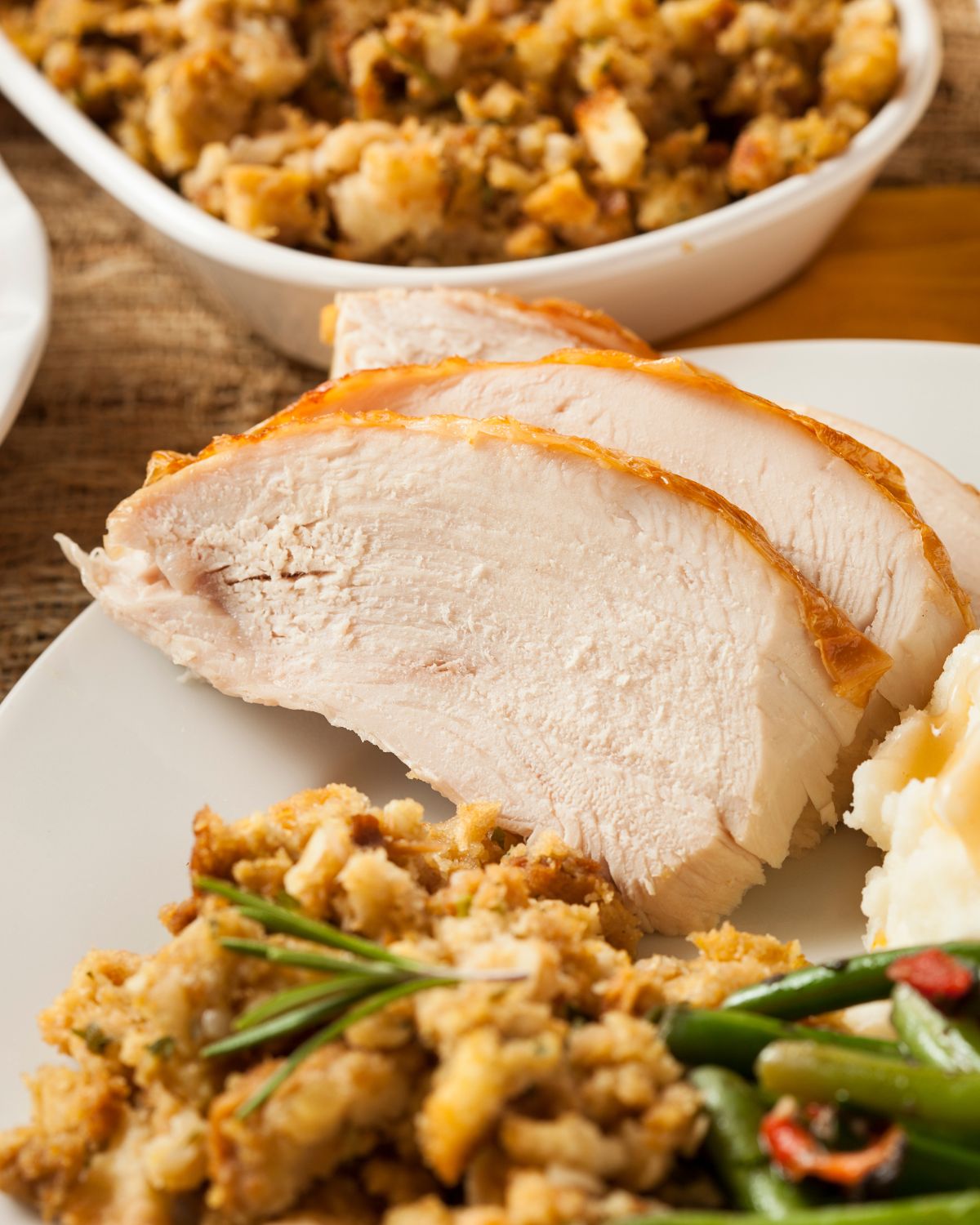
WE RECOMMEND: Turkey in the Roaster Oven
Cooking a Turkey
For most of us, the traditional way to cook a holiday turkey is roasting in the oven. It’s the way my Grandma always did it and I use her exact recipe still – the best turkey recipe, in my opinion.
However, there are so many other ways to cook a deliciously, juicy turkey. We share our favorites, along with how long to cook a turkey and when to tell when you turkey is done. Feel free to experiment and try something new with you turkey this year.
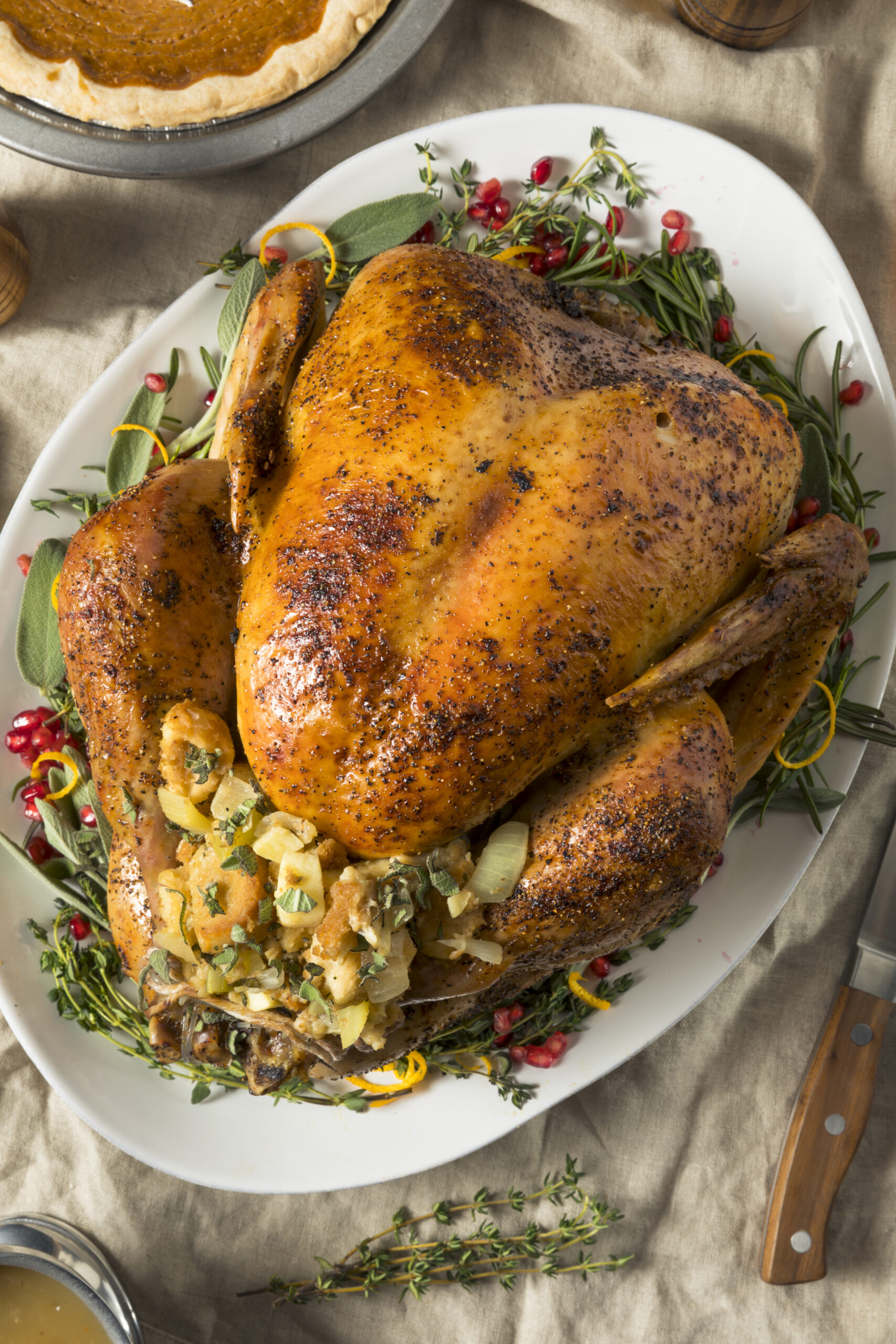
Ways to Cook a Turkey
There are many ways to cook a turkey and every family has a traditional Thanksgiving turkey recipe. But if you’re looking to go beyond the traditional roast turkey recipe, we have some great options.
Each of these methods offers a unique cooking experience, so choose the one that suits your preferences, equipment, and the flavor you desire for your turkey. They will all yield a perfectly cooked turkey recipe for Thanksgiving this year.
- Roasting: Roasting in the oven is a classic method. It involves cooking the turkey in the oven in a roasting pan. Usually, you place the turkey on a roasting rack in the pan, resulting in a beautifully browned bird with tender meat.
- Deep-Frying: Deep-frying the turkey can give you a crispy skin and juicy turkey meat. However, it requires caution, a large pot, and ample outdoor space to ensure safety. There is nothing like turkey that is deep fried!
- Spatchcocking: Spatchcocking involves flattening the turkey by removing the backbone, the pound turkey flat. This method reduces cooking time and ensures even cooking, with crispy skin.
- Grilling: Grilling a turkey imparts a delicious smoky flavor. It’s perfect for those who love outdoor cooking, and it can be done on a gas or charcoal grill.
- Smoking: Smoking the turkey adds a rich, smoky flavor. You’ll need a smoker or a grill set up for indirect heat, and it’s a bit more time-intensive. Make sure you understand how to use your smoker to make the turkey right.
- Slow-Cooking: Slow-cooking in a crockpot or slow cooker is a hassle-free option. The turkey cooks low and slow, resulting in tender, flavorful meat.
- Braising: Braising involves cooking the turkey in a flavorful liquid, often in a covered pot. This method can result in moist, fall-off-the-bone meat.
- Brining and Roasting: Brining involves soaking the turkey in a saltwater solution before roasting. This adds flavor and helps keep the meat moist. This is my go way – it makes the moistest turkey we have ever had.
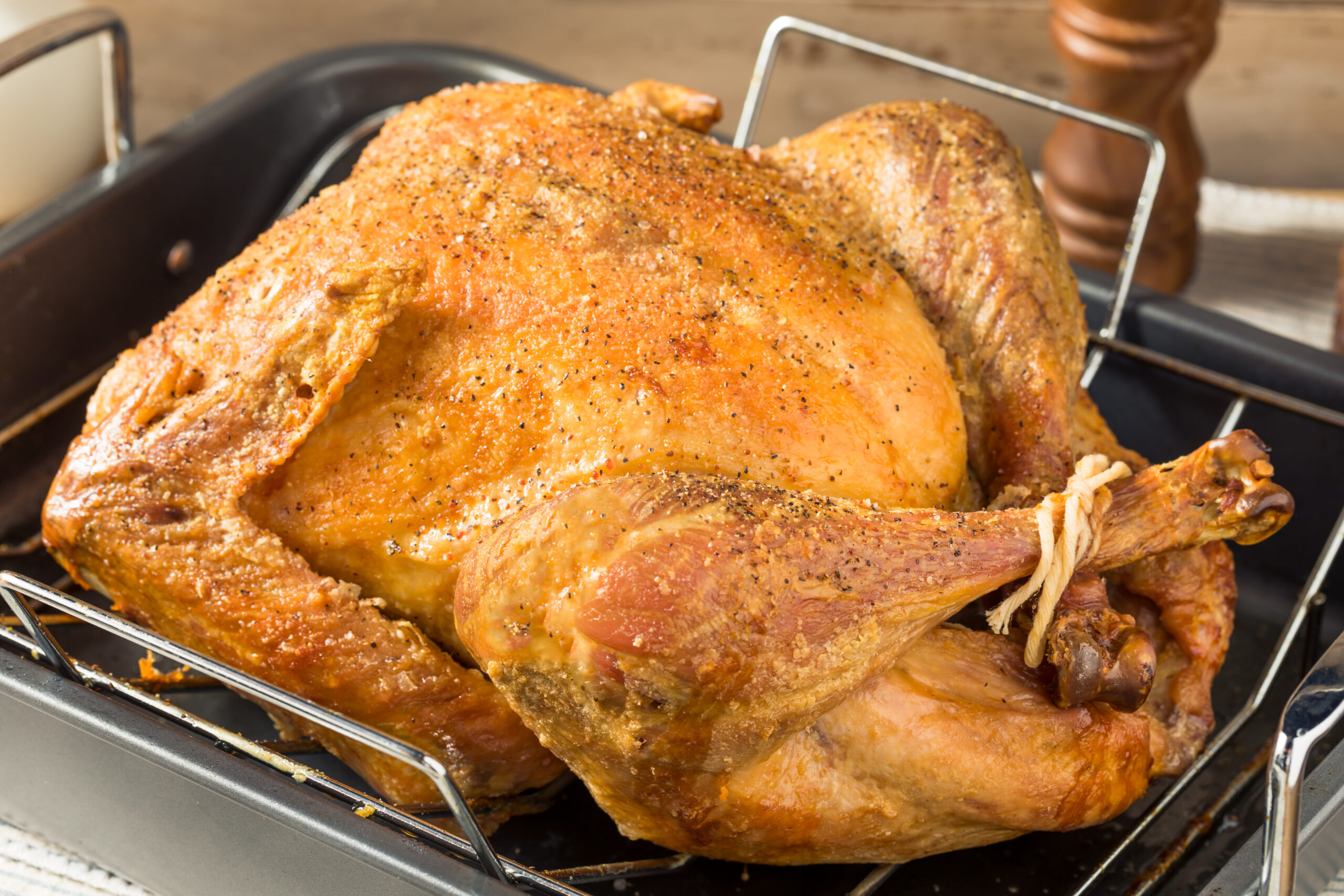
WE RECOMMEND: Crock Pot Turkey and Stuffing
How Long to Cook a Turkey
The biggest mistake is overcooking your bird. You need to make sure you remove the turkey before it dries out. No one wants dry turkey during the holidays.
A general rule of thumb is 13 minutes per pound at 350°F for an unstuffed turkey or, if stuffing the bird, 15 minutes for every pound of turkey.
Cooking times can vary based on factors such as the turkey’s size, oven or equipment accuracy, and your specific cooking method. Here are some turkey cooking times to help you:
- Roasting: The general rule for roasting a turkey is about 15 minutes per pound at 325°F. A 12-pound turkey would take approximately 3 hours.
- Deep-Frying: Deep-frying requires about 3-4 minutes per pound at 350°F. A 12-pound turkey would take around 36-48 minutes.
- Spatchcocking: Spatchcocking reduces cooking time. Typically, a spatchcocked turkey takes about 10-15 minutes per pound at 325°F . A 12-pound turkey would take roughly 2-2.5 hours.
- Grilling: Grilling times vary, but a general guideline is 12-15 minutes per pound at medium-high heat. A 12-pound turkey might take around 2.5-3 hours on the grill.
- Smoking: Smoking times are longer due to lower temperatures. Plan on about 30-40 minutes per pound at 225-250°F. For a 12-pound turkey, it could take 6-8 hours or more.
- Slow-Cooking: In a slow cooker, allow 5-7 hours on low for a 12-pound turkey. Cooking times may vary depending on the slow cooker model and the recipe.
- Braising: Braising can take 2.5-3 hours for a 12-pound turkey when simmered in liquid over low heat.
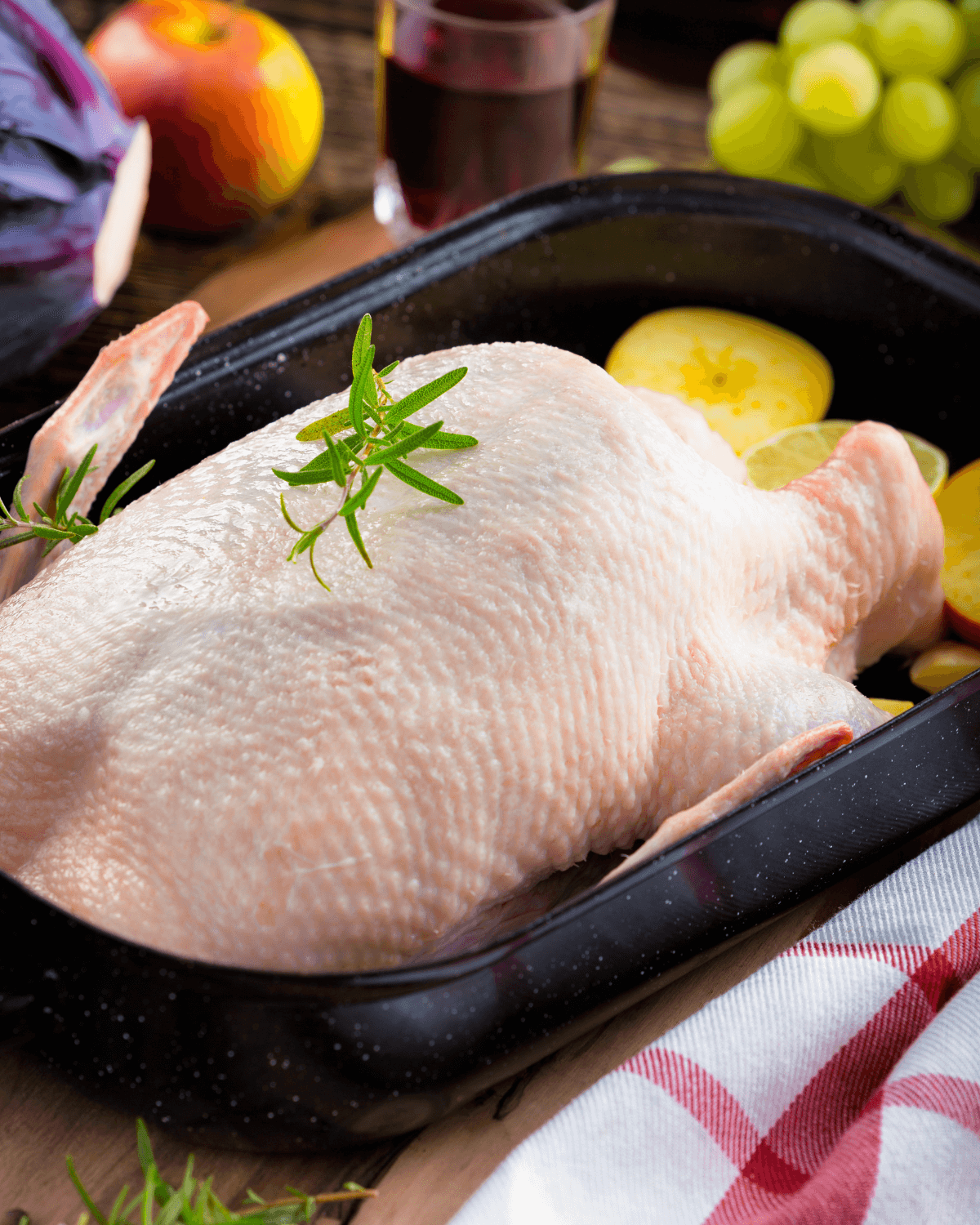
What Temperature to Cook a Turkey
Ensuring that the meat reaches the correct temperature helps guarantee that it’s safe to eat and free from harmful bacteria and ensures a juicy and delicious turkey.
Using a reliable meat thermometer is essential to accurately gauge the internal temperature of the turkey. Make sure you account for carryover cooking during the turkey rest time.
To be certain the entire turkey is thoroughly cooked, you can check the internal temperature in multiple places, including the breast, thigh, and wing joint. All these areas should register at least 165°F before considering the turkey done. Here’s how to check:
- Breast Meat: Insert your meat thermometer into the center of the turkey breast.
- Thigh Meat: The thigh meat tends to cook more slowly. Insert the thermometer into the thickest part of the thigh without touching the bone.
- Stuffing (if used): If you’re cooking stuffing inside the turkey, the stuffing itself should also reach an internal temperature of 165°F to ensure that any potential bacteria are killed.
WE RECOMMEND: Turkey Cooking Times in a Convection Oven
Carving a Turkey
Carving a turkey can be intimidating for cooks of any skill level. But carving a turkey doesn’t require a master chefs skills. You just need a little know how and the right tools.
We’ll show you what you need to know to carve a beautiful plate of poultry. The most important tip to remember is to allow the turkey to rest – do not carve as soon as you take the turkey from the oven.
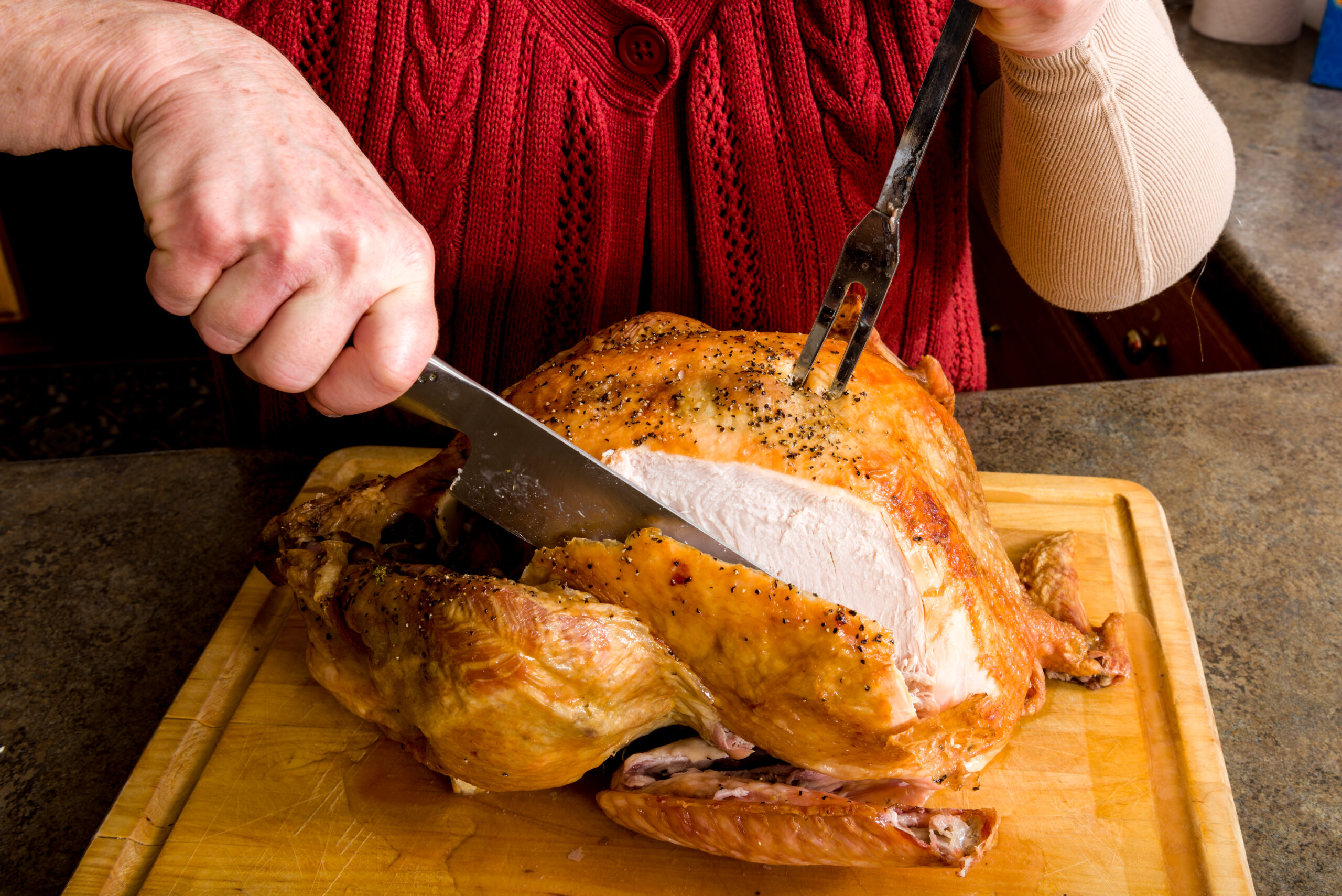
What Tools You Need to Carve a Turkey
Having the proper tools on hand will make the process of carving a turkey much smoother and safer. These are our recommendations:
- Carving Knife
- Carving Fork
- Cutting Board
- Platter
- Kitchen Shears (Optional)
- Carving Gloves (Optional)
WE RECOMMEND: How to Carve Turkey Breast (the rest of the bird)
How to Carve a Turkey
Carving a turkey can seem intimidating, but with a bit of practice and these steps, you’ll be able to present a beautifully carved turkey to your guests.
- Let It Rest: Allow the turkey to rest for about 20-30 minutes after it comes out of the oven. This lets the juices redistribute, ensuring a juicy bird.
- Start with the Legs: Begin by removing the legs. Hold the turkey steady with the carving fork and use the knife to cut through the skin between the leg and the body. Then, use the knife to separate the leg and thigh from the body by cutting through the joint. Repeat on the other side.
- Remove the Wings: Next, remove the wings. Pull the wing away from the body to expose the joint, then cut through it with the knife. Repeat on the other side.
- Separate the Thighs and Drumsticks: Separate the thigh from the drumstick by finding the joint and cutting through it. Repeat on both sides.
- Slice the Breast: To slice the breast, make a horizontal cut just above the wing joint. Then, angle the knife slightly and make thin slices parallel to the breastbone. Continue until you’ve removed all the breast meat.
- Carve the Thigh and Drumstick Meat: Slice the thigh meat and drumstick meat separately into thin slices, cutting parallel to the bone.
- Serve on a Platter: Arrange the carved meat on a platter, and you’re ready to serve.
WE RECOMMEND: Homemade Turkey Dressing and Stuffing Recipes
What to Serve with Turkey
When it comes to holiday meals, the side dishes are often more important than the main dish. Many families, like mine, have been making the same recipes for generations.
Whether you want to stick with tradition or branch out and try something new, we have some delicious recommendations.
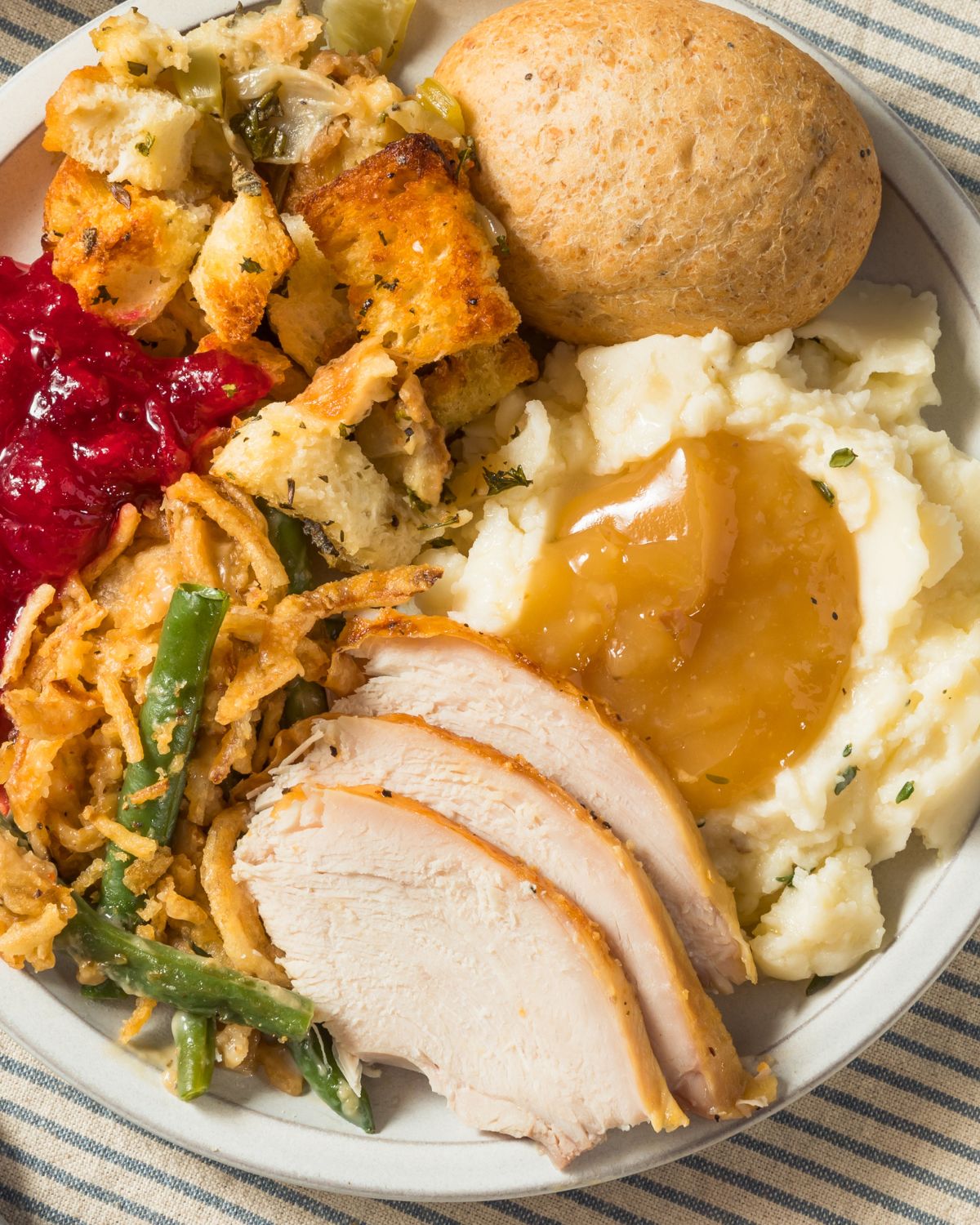
Our Best Stuffing Recipes
When it comes to stuffing, there are two schools of thought – in the bird or not. Personally, I’m a big fan of stuffing in the bird (just like my Grandma always made). It gives it such great flavor.
However, if you prefer to not stuff your bird, you can make most stuffing recipes as a casserole. Then, you can always fill the cavity with herbs, citrus and other flavor enhancers.
Fun fact, it’s called “stuffing” when it’s cooked in the bird and it’s called “dressing” when it’s not.
Here are some of our favorite stuffing/dressing recipes:
- Classic Stuffing ⬅️ Use this recipe – it’s my Grandma’s!
- Corn Bread Stuffing
- Sourdough Stuffing
- Slow Cooker Mushroom Stuffing
- Homemade Stove Top Stuffing
- Sausage and Apple Stuffing
- Rice Stuffing
WE RECOMMEND: Best Thanksgiving Side Dishes
Our Best Gravy Recipes
Homemade gravy is a cinch to make using our easy technique. Here are some of our favorite recipes:
- Turkey Gravy with Drippings ⬅️ This is my fail-proof recipe!
- Turkey Gravy without Drippings
- Giblet Gravy
WE RECOMMEND: Fresh Cranberry Recipes for the Holidays
Favorite Thanksgiving Side Dishes
Here are some of our favorite side dishes to round out a holiday meal:
- Mashed Potatoes
- Sweet Potatoes
- Cheesy Broccoli Casserole
- Cranberry Sauce ⬅️ Make this recipe! It’s a fan favorite!
- Brussels Sprouts
- Carrots
- Dinner Rolls
- Pumpkin Pie
WE RECOMMEND: Best Easy Pie Recipes
What to Do With Leftover Turkey
Cooking the perfect juicy turkey recipe is just the beginning. One of the best parts of cooking a turkey for Thanksgiving is the leftovers.
But, turkey leftovers can easily become boring and uninspired. We have some great tips for storing leftover turkey and our favorite ways to serve leftovers your family will love. Why not try a new recipe this year?!
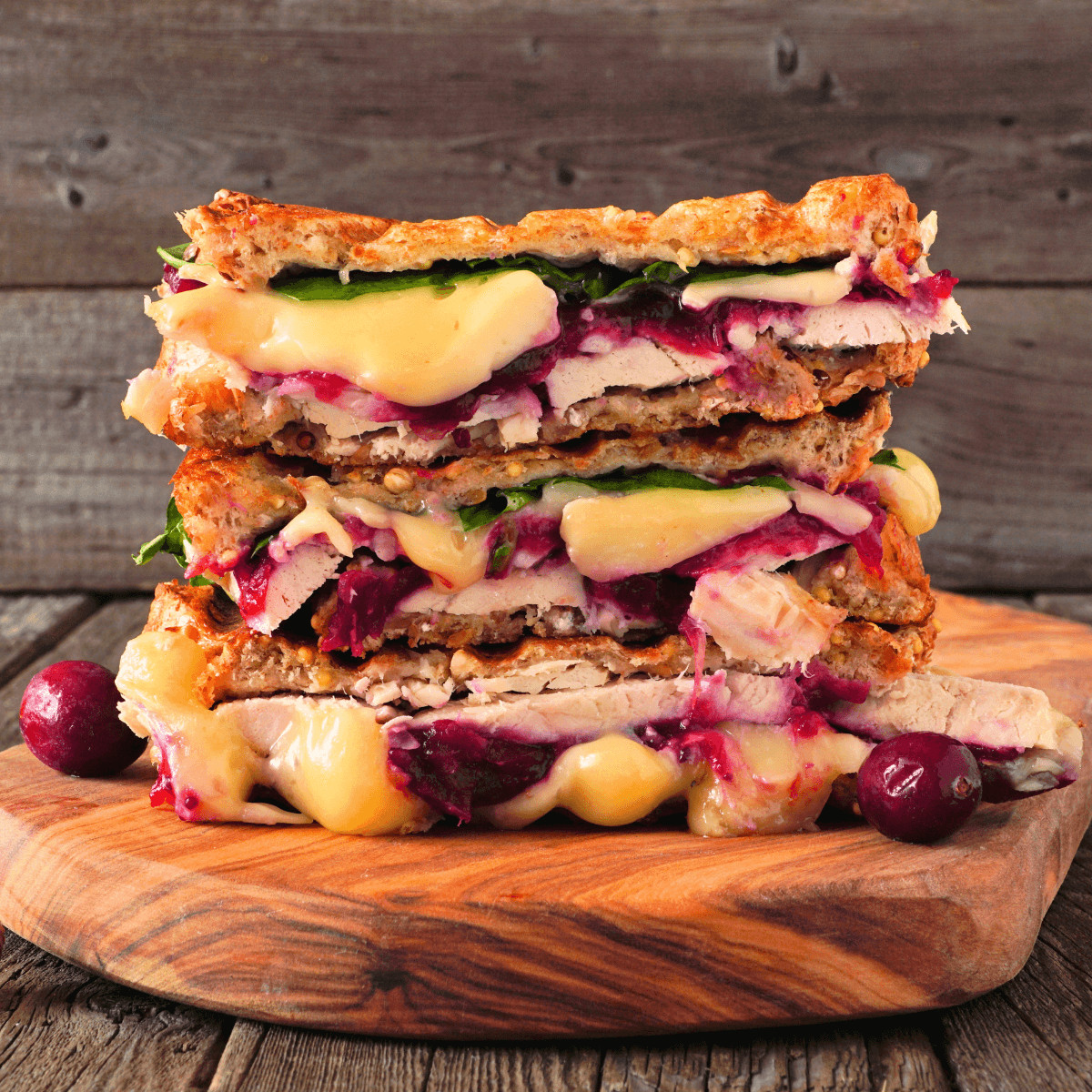
How to Store Leftover Turkey
Make the most of your holiday leftovers with proper storage. Here are some guidelines to help you store leftover turkey safely and enjoy it the next day:
- Cool Quickly: Allow the leftover turkey to cool at room temperature for no more than 2 hours after cooking. This prevents bacteria growth.
- Divide into Portions: Slice or carve the leftover turkey into smaller portions for easier storage and reheating.
- Refrigerate Promptly: Place the portions in airtight containers or resealable plastic bags and refrigerate them within 2 hours of cooking. Use shallow containers to facilitate rapid cooling.
- Label and Date: Label the containers with the date to keep track of freshness. Use older leftovers first.
- Use Within 3-4 Days: Consume leftover turkey within 3-4 days to ensure freshness and safety.
- Freeze for Longer Storage: If you won’t use the leftovers within a few days, freeze them in airtight containers or freezer bags. Turkey can be safely stored in the freezer for up to 2-3 months.
- Wrap Properly: To prevent freezer burn, ensure there is minimal air inside the storage containers or bags. Consider using a double layer of plastic wrap or aluminum foil for added protection.
- Thaw Safely: When ready to use frozen leftovers, thaw them in the refrigerator or use the defrost function on your microwave. Avoid thawing at room temperature, as it can promote bacterial growth.
- Reheat Thoroughly: Reheat leftover turkey to an internal temperature of 165°F to ensure it’s safe to eat.
WE RECOMMEND: Recipes for Leftover Turkey
Our Favorite Leftover Turkey Recipes
Here are some of our favorite recipes for using leftover turkey and sides:
- Leftover Turkey Paninis ⬅️ Try this recipe – it’s my husband’s favorite!
- Leftover Thanksgiving Casserole ⬅️ My son’s favorite!
- Turkey and Rice Soup
- Turkey Pot Pie
- Turkey Noodle Casserole
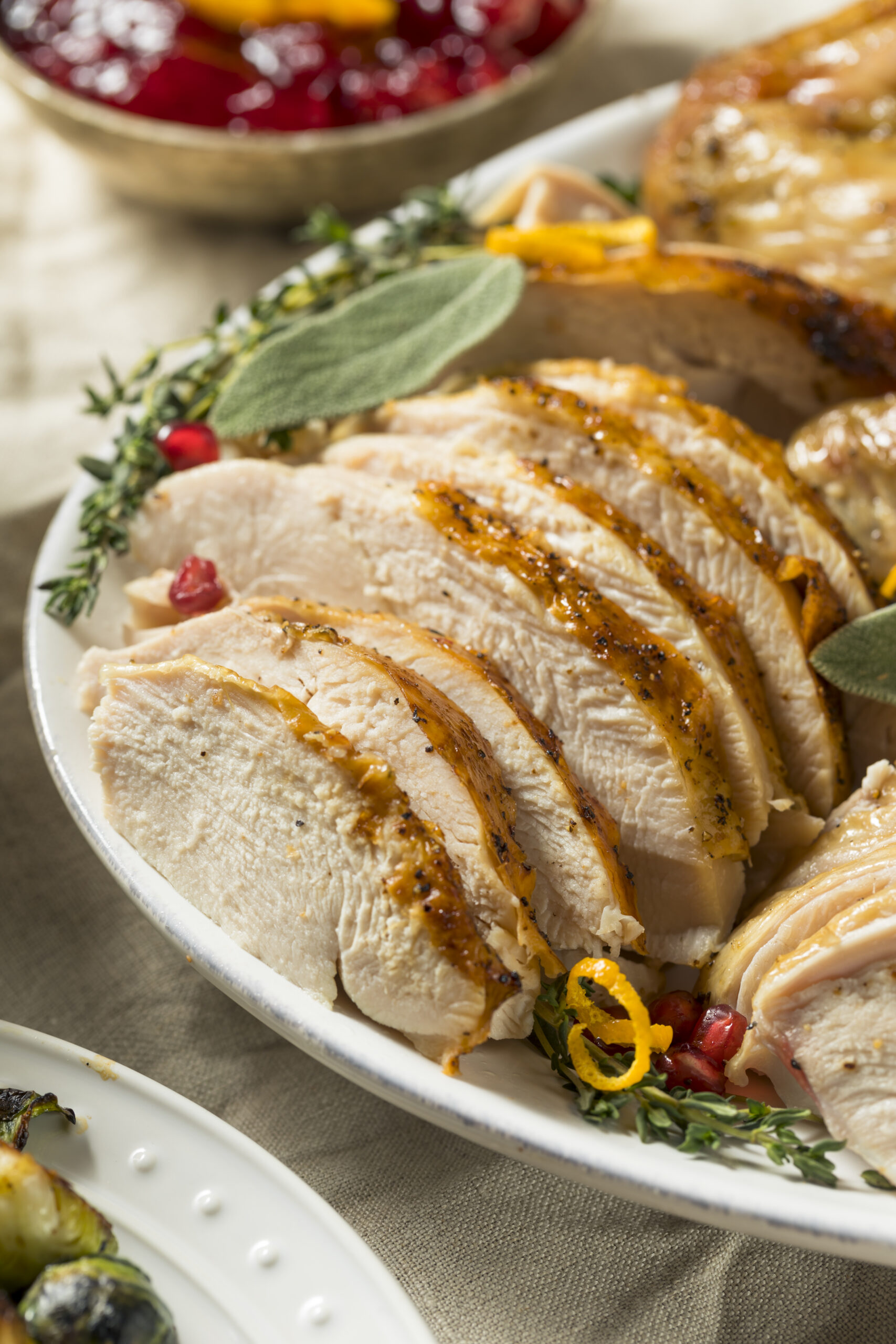
Turkey FAQs
Turkey Tips: Expert Advice for Making Perfect Turkey
Cooking a perfect whole turkey is easy when you know the right steps. Here are the key things you need to know:
- Preparation is Key: Choose the right type of bird for you. Be sure to prep and clean your turkey properly. And, allow enough time for proper thawing if using a frozen bird.
- Season Liberally: Use plenty of seasoning. Remember, turkeys are large and require a bit of seasoning. Brining is another great option.
- Cook to the Right Temperature: Don’t over cook your turkey. Use a reliable meat thermometer to tell when your turkey is cooked through.
- Let it Rest: Allow the turkey to rest for 20-30 minutes before carving.

